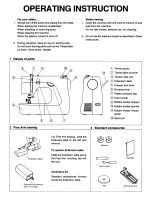
800-422-2952 www.babylock.com
Looking for a quick, easy way to make your hems invisible?
This foot was designed specifically for easily stitching a
blindhem on a serger. You can also use this foot for quick
stitching along fabric edges.
Machine SettingS
Needle:
Right needle
Sewing foot:
Blindhem Foot
Upper knife:
Engaged “UNLOCKED”
Thread tension:
Set for 2-thread
Stitch width:
4.5 mm
Stitch length:
3.5
inStructionS:
1. For hemming, fold fabric as shown in diagram.
2. Place garment with wrong side up under the presser foot.
Before you begin serging, check the needle dropping
position. The needle should just catch the fold of the
fabric.
3. Once the needle dropping position has been determined,
set the adjustable guide on the foot to the fold edge of the
fabric. Move the adjustable guide by loosening the screw
on top of the foot, adjusting the plate right or left and
retightening the screw.
Blindhem Foot
(BLe-BLhFS)
instructions
Machine SettingS
Stitch type:
3-thread rolled edge
Needle:
Right
Stitch width:
M
Stitch length:
3-4 rolled hem
Upper knife:
Engaged “UNLOCKED”
Differential feed: N - 0.6
Sewing speed:
Slow to moderate speed
1. Remove the left needle from the machine. Set machine
to narrow rolled edge. (Refer to your instruction manual
for details on changing your machine to narrow rolled
hemming.)
2. Replace the standard presser foot with the beading
foot.
3. Stitch length setting is set between 3-4 mm, according
to the size of beads used.
4. Position beads into beading foot as illustrated in Fig. A.
5. Place edge of fabric you are attaching the beads to
under the presser foot, lower presser foot, and stitch.
note: It is recommended to sew a test sample before
sewing your actual garment to determine the correct stitch
length and test your settings.
Beading Foot
(BLe-BF)
instructions
BeaD PintucKing (Flatlock on Fold):
1. Set up your machine for a 2 or 3 thread flat lock stitch
(refer to your instruction manual). Disengage (or LOCK)
the blade into the down position.
2. Place the folded edge of your fabric under the presser
foot.
3. Insert the beads into the beading foot and position the
fabric fold against the beads.
4. Sew beads to the folded edge of your fabric.
5. If you do not want to form a tuck in your fabric as you
are sewing the beads to the folded edge of your fabric,
use the 2 thread flatlock stitch. Sew beads to the folded
edge of your fabric then pull to flatten the stitches.
Serge pearls, piping, cording, and more to the edge of
fabric with ease and speed. This one-step foot will give
all of your surface embellishments a professional finish.
Fig. A
Machine SettingS
Stitch type:
4 Thread Overlock
Needle:
Both
Sewing foot:
Cording foot
Upper knife:
Engaged “UNLOCKED”
Stitch width:
3.5 -7.5 mm
Stitch length:
2.5
Differential feed:
2
inSerting the FaBric:
1. Raise the sewing foot.
2. Raise the needles to the highest position.
3. Layer the bottom fabric, cording tape and top fabric
right-sides together under the sewing foot.
4. Make sure the edge of both fabrics and cording tape are
even, then insert up to the knife.
5. Lower the sewing foot making sure that the cording (piping)
is in the groove of the foot.
6. Serge keeping the layers together, the edges even, and the
cording (piping) in the groove.
Machine SettingS
Stitch type:
4 Thread Overlock
Needle:
Both
Sewing foot:
Cording foot
Upper knife:
Engaged “UNLOCKED”
Stitch width:
3.5 -7.5 mm
Stitch length:
2.5
Differential feed:
2
inSerting the FaBric:
1. Raise the sewing foot.
2. Raise the needles to the highest position.
3. Layer the bottom fabric, cording tape and top fabric
right-sides together under the sewing foot.
4. Make sure the edge of both fabrics and cording tape are
even, then insert up to the knife.
5. Lower the sewing foot making sure that the cording (piping)
is in the groove of the foot.
6. Serge keeping the layers together, the edges even, and the
cording (piping) in the groove.
This foot easily serges decorative cording and piping as it finishes
the seams in one step. It also adds stability as you serge by
keeping the material flat. Choose the 3mm or 5mm for various
sizes of cording and piping, depending on the look you desire.
This foot easily serges decorative cording and piping as it finishes
the seams in one step. It also adds stability as you serge by
keeping the material flat. Choose the 3mm or 5mm for various
sizes of cording and piping, depending on the look you desire.
cording Foot
5mm (BLe-cF5)
instructions
cording Foot
3mm (BLe-cF3)
instructions
LNIS-BLE1AT




















